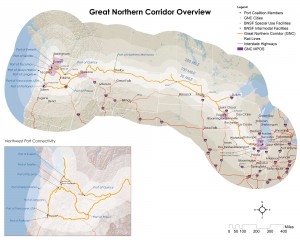Great Northern Corridor Coalition embarks on improving freight movement
 Critical infrastructure from the Great Lakes to the Pacific includes, ports, rail and highways
Critical infrastructure from the Great Lakes to the Pacific includes, ports, rail and highways
The Port of Vancouver USA has joined the effort to improve the Great Northern Corridor into a seamless, multistate freight corridor consisting of rail and road networks. The Great Northern Corridor spans the northern tier of the western United States from Chicago through Wisconsin, Minnesota, North Dakota, Montana, Idaho, Washington and Oregon. Representatives from these states have formed the Great Northern Corridor Coalition to promote regional cooperation, planning and shared project implementation for moving freight.
“This interconnected system of highways, rail and ports is vital to communities,” said Curtis Shuck. “We rely on this multimodal transportation system to move U.S. products to global markets and deliver necessary commodities to our communities.”
More than 203 million tons of freight moves over this corridor, and that number continues to grow as the economy improves. The Coalition is working to strengthen the corridor in order to promote economic growth for neighboring communities and accommodate the demand for safe, efficient and environmentally sound transportation services.
The first step is underway, conducting a Strength, Weaknesses, Opportunities and Threats analysis to identify opportunities to improve the technology, operations and infrastructure along the corridor. The study is being conducted by Olsson Associates, Parsons Brinckerhoff and The Beckett Group with funding through the Federal Highway Administration’s Multistate Corridor Operations and Management Program, as well as, funding from coalition partners.
The next step to strengthening the corridor will be using the results from the SWOT analysis to identify possible strategies that will improve multimodal transportation system management and operations.
“This is a complex network of interconnected transportation systems that serves 27 million Americans,” said Shuck. “The transportation system unifies metropolitan and industrial centers like Chicago, Minneapolis, Portland and Seattle across hundreds of miles of critical agricultural and energy resource regions in rural areas in Montana, North Dakota, Idaho and Washington.”
The SWOT analysis is expected to be completed by fall 2014 with analysis of identified strategies and initiatives beginning immediately after the SWOT.
Coalition partners include:
Washington State Department of Transportation, Oregon Department of Transportation, Idaho Transportation Department, Montana Department of Transportation, North Dakota Department of Transportation, Minnesota Department of Transportation, Wisconsin Department of Transportation, BNSF Railway, Washington Public Ports Association, Port of Vancouver USA, Port of Seattle, Port of Tacoma, Port of Everett, Port of Quincy, Port of Northern Montana, Port of Pasco, Port of Grays Harbor, Port of Portland, and Port of Longview.
